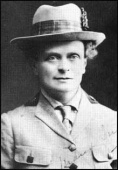Elsie Inglis 1864 - 1917
 Elsie and her sister attended the young ladies Institution in Charlotte Square - a school that concentrated on academic attainment rather than social graces.
Elsie and her sister attended the young ladies Institution in Charlotte Square - a school that concentrated on academic attainment rather than social graces.
Elsie was one of the first pupils at Dr Sophia Blake’s Medical School. However Elsie did not like the strict regime so she and two other sisters, set up their own college at 30 Chambers Street in 1887. (Medical College for Women)
She studied medicine at the Universities of Glasgow and Edinburgh, gaining a Bachelor of Medicine and Master of Surgery.
She practised medicine and midwifery briefly in Dublin and lectured in gynaecology in London, setting up a women’s residence in 1898. She became the first resident surgeon at the New Hospital for Women where she worked with Elizabeth Garrett Anderson, the first woman to qualify as a doctor in Britain.
On returning to Edinburgh she set up practice with Dr Jessie MacGregor in Atholl Place moving later to Walker Street. She practised at the dispensary at Morrison Street - here she worked amongst the poor. Slum life impacted most heavily upon women and this made a deep and lasting impression on her, particularly regarding the powerlessness of women in a strongly misogynist culture.
Elsie was shocked when she witnessed a drunken husband kicking his ill wife out of their home. She declared –
“He ought to have been horsewhipped, and when I have the vote I shall vote that all men who turn their wives and families out of doors….shall be horsewhipped. And if they make the excuse that they were tipsy, I should give them double.”
The problem was nationwide… She wrote to he father saying –
“You don’t know the trouble we have here with husbands… Any idea that anybody is to be thought of but themselves never enters their lordly minds, and the worst of it is, those stupid idiots of women don’t seem to think so either.”
She went on a social and political crusade to improve the condition of women. After her father’s death she set up an appeal to raise funds to open a Nursing Home in George Street. This extended to the Hospice at 219 High Street that was staffed entirely by women. The gynaecology unit was also a teaching hospice.
In 1905 she was appointed as a consultant at the Edinburgh Hospital founded by Dr Jex Blake (who had retired) and supported its amalgamation with her hospice in the High Street in 1910.
Her period at the New Hospital for Women in London strongly reinforced her feminism. (Elizabeth Garrett Anderson founder of the hospital had been involved in the early days of the suffrage campaign and her sister Millicent Fawcett was president of the NUWSS.) During that period Elsie made her first suffrage speech. In Edinburgh she became honorary secretary of the ENSWS (Edinburgh National Society for Women’s Suffrage) She became involved in organising and supervising speakers, demonstrations and processions. She travelled around Scotland as a speaker, presenting incidents from her medical experience to illustrate the injustices she daily witnessed, such as husbands refusing consent for life saving operations for their wives, or insisting on having them released from hospital so that they could go back to looking after the house. When the SFWSS (Scottish Federation of Women’s Suffrage Societies) was formed she became honorary secretary of that too.She was opposed to the militancy advocated by the Suffragettes. She claimed that the actions of the WSPU took away support from the SFWSS. It was only legal protest that won support. A favoured method of such protest was to exploit loopholes in franchise legislation, but it was the failure of these cases that caused the militants to become so in the first place.
In 1906 the first contested university seat occurred and a group of women centred around Elsie and Jessie Chrystal Macmillan applied for voting papers and formed themselves into a committee.
The War split the suffrage movement both suffragists and suffragettes. Elsie sided with the pro-war. She was of the opinion that the war offered an opportunity for women to provide invaluable service to the nation state which in time would be recognised and prove them worthy of the vote. It allowed women to refute the well worn argument that since they had played no part in the defence of their country they were not entitled to have a say in the way it was run.
Elsie’s work during the War is well documented and recognised.
References:
William W J Knox: Lives of Scottish Women, Women and Scottish Society 1800-1980.
Photo from Spartacus (http://www.spartacus.schoolnet.co.uk/Winglis.htm)
